NORTH WALES COAST
RAILWAY: NOTICE BOARD
Rheilffordd arfordir gogledd Cymru
5 April 2010
 Last issue
Last issue 2010
Archive
2010
Archive Contributions and comments are encouraged: see the Contributions Page
This site is dedicated to all our regular contributors and supporters, and especially the all rail staff of North Wales.
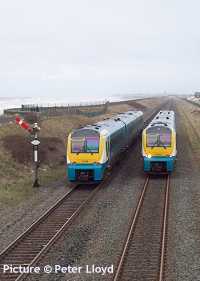
Coming events:
Tuesday 6 April North Wales Railway Circle Photographic Competition
Friday 9 April Clwyd Railway Circle Have Pass Will Travel. A slide show by Andy Lawton containing Steam, Diesels and Electrics from late 1950s, 1960s and 1970s showing the development of his hobby and subsequent career.
Friday 9 April Altrincham Electric Railway Preservation Society FROM THE ADRIATIC TO THE DANUBE Illustrated presentation of the current scene by John Myddelton
Monday 12 April Wrexham Railway Society My 200 best slides by John Feild - a look back at railway photography. (Change of programme)
Tuesday 13 April. The 8E Railway Association (Northwich); Chris Banks presents 'Engine Sheds - Part 1'
Monday 19 April. RCTS Meeting in Chester at 19.45. Branch AGM followed by members' digital presentations.
Tuesday 20 April North Wales Railway Circle China Steam
23-25 April. Llangollen Railway Spring steam gala in aid of the Patriot Appeal and Corwen extension fund raiser. A visiting engine is expected as a special LMS guest.
Saturday 24 April. Steam on the Coast. PMR Tours. The Welsh Dragon (Lincoln) - Crewe - Holyhead.
Saturday 24 April. Chester Model Railway Club & Ffestiniog Railway Dee & Mersey Group. The Thames Valley Express. Excursion train from Hooton to Windsor picking up at Bache, Chester and Crewe with option to leave train at Harrow & Wealdstone for London. MkII coaches top and tailed by Class 67 Diesel locomotives.
May 2010
Tuesday 4 May North Wales Railway Circle David Lindsay: Around Lake Maggorie & Milano.
Saturday 8 May Mid-Cheshire Rail Users Association Excursion. Most Mid Cheshire Line Stations, Manchester
Piccadilly, Stockport and Crewe to Oxford, Bath (for the East Somerset Railway) and Bristol. Booking info
See the Calendar page for more details

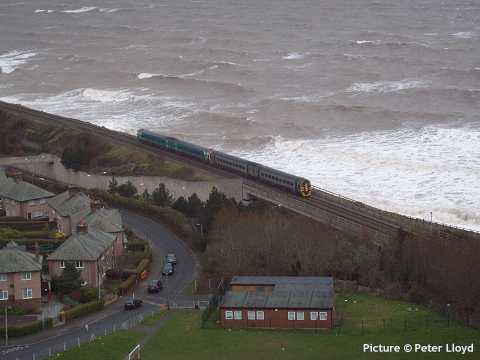
It's a stormy day on 31 March as 1G50 13:23 Holyhead to Birmingham International. The units are 158 824 +158 839 about to enter Penmaenrhos tunnel. (Peter Lloyd)
Cabride Auction thanks
Thanks to everyone for their interest in or charity cabride action. Total ledges of over £1600 resulted, and the highest bidders have now been contacted by Virgin Trains to arrange their rides.Good Friday on the Talyllyn - with Alan Crawshaw
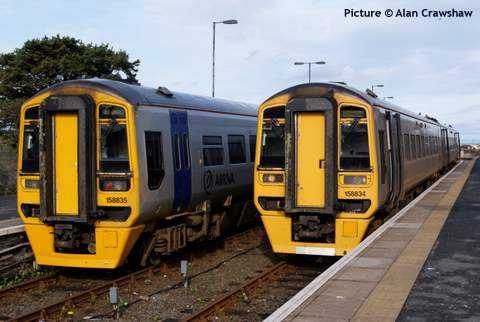
No bank holiday lie-in for Rowan and I, we drove to Porthmadog to catch the 07:49 departure, alighting at Tywyn where two consecutively numbered 158s, 834 and 835, passed each other. It's by far the most relaxing way of travelling down the coast. The coastal scenery is wonderful, the fare is very reasonable and instead of paying for the Talyllyn Railway car park, you get a discount by producing your mainline tickets.
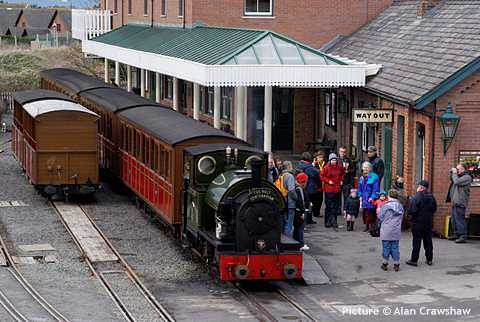
We had an hour to wander around the town, drink coffee in the excellent Talyllyn cafe and photograph the first train of the day as passengers lined up in front of Edward Thomas for the obligatory cheesy pictures (above). This season, the 10:30 and return are carrying a headboard commemorating the centenary of the birth of L.T.C. (Tom) Rolt, who played a large part in saving this line from oblivion in 1950, making it the world's first preserved railway.
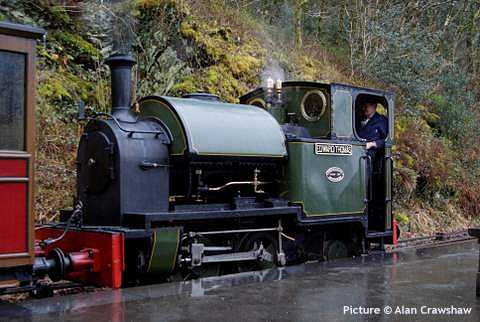
We enjoyed lovely views as we ascended to the terminus at Nant Gwernol, where you can alight to watch the loco run round. There are no facilities here, so the train stops at Abergynolwyn for half an hour to allow a visit to the tea room. The threatened heavy rain arrived (above) but the downpour had ceased by the time were were back at Tywyn. The fate of many other narrow gauge railways is told in the station's narrow gauge museum which we visited before returning to the mainline station for the short run to Fairbourne.
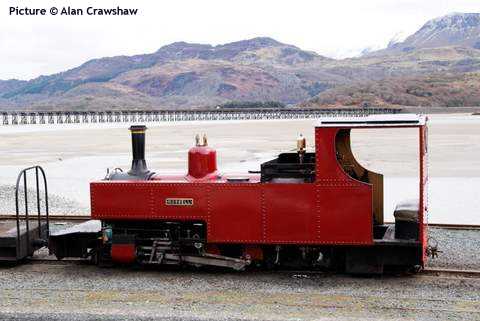
My wife tells me that we'd ridden on the Fairbourne Railway when the children were young, but I have no recollection of this. It has a long, complex history but the ride itself is disappointing, a trundle along the coast with the sea hidden from view by sand dunes. The highlight is the view of Barmouth bridge at the terminus, where a ferry connects with the train to take you to the town. We returned on the railway and caught the 15:44 departure back to Porthmadog.
Nuclear news
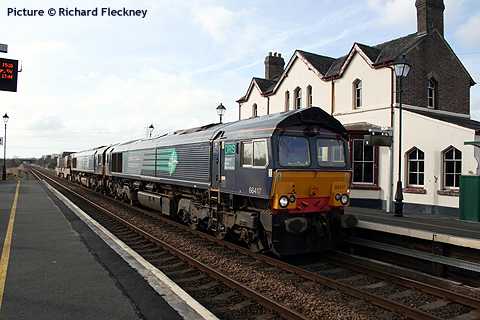
Train 6K41, 14:58, Valley - Crewe flasks, has been running regularly of late: above, it seen on 26 March at Llanfair PG with 66 417 and 66 426 (Richard Fleckney). In December Wylfa power station, which has been in service since 1971, will cease to generate and begin the long process of decommissioning.
However, it has now been announced that German energy firms RWE and E.ON plan to build a new station, known as 'Wylfa B' ,which they hope to have 'up and running' by 2020. However, formal planning permission would not be sought until 2012, a spokesman told the press: 'Building nuclear power stations is a very complex, major project and as a result the Government has put in a lot of steps before you can even get to apply for planning permission.' This project is sure to divide the people of Anglesey into those who welcome the jobs created and those with environmental objections, who have already set up a pressure group called PAWB (People against Wylfa B) whose website is laid out in a frightening style.
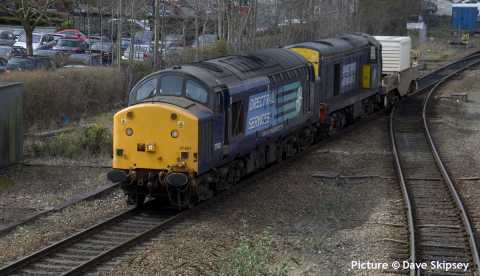
Back to railways: An usual combination of 37 601 and 20 304 head eastbound through Chester on 30 March, 150 minutes early, frustrating a BBC news team who had asked us for the timings. (Dave Skipsey)
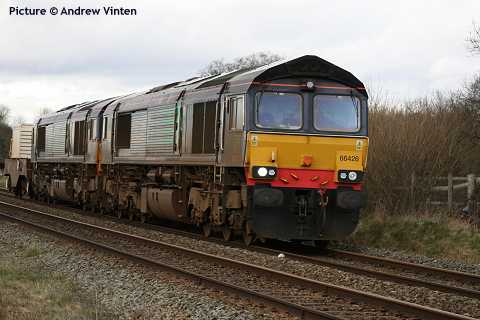
More usual power for the flasks these days: 66 426 and 66 428 seen at Rowton on 1 April (Andrew Vinten)
Chester freight
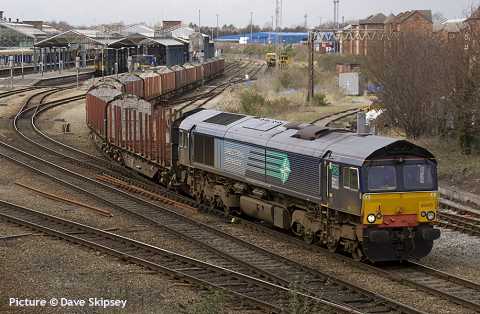
66 420 hauls 6C19, 12:06 Chirk - Carlisle timber empties through Chester, 30 March (Dave Skipsey)
On the fairway - with Route19

An often-ignored and underrated photographic location is this one, looking from the pavement of the main road through Deganwy over the Maesdu Golf Course and Conwy Bay. Above, On Saturday 27 March, 150 237 trundles past with the 08:52 Blaenau Ffestinog- Llandudno.

175 002 hurries past the green with the 10:10 Llandudno- Llandudno Junction.

175 109 passes the signal and the bunch of uninterested golfers as it works the 11:26 Llandudno Junction- Llandudno.
Roaming Yellow Growler
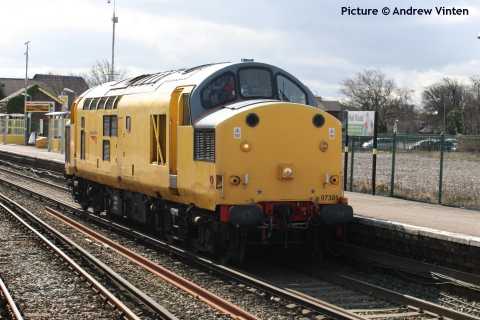
97 301, one of the four Class 37s overhauled for use by Network Rail, ostensibly, on the Cambrian lines ERTMS project, has recently seen use on 'route refresher' duties over a wider area. On 3 April it ran as 'light engine' 0Z97 from Derby to Hall Road on the Merseyrail Northern line; it was due to undertake a number of trips but did one full trip and a couple of 'part ' trips. The picture shows it at Hall Road station.
Inquest on level crossing tragedy
An inquest has been held in Caernarfon into the death of an 83-year-old lady at a user-worked level crossing near Penrhyndeudraeth back in September 2009.
Sally Hudson, who used to run the Saltings Pottery, had lived at the house for nearly 40 years. It was accessible only across the private level crossing, which has a telephone with which users with vehicles are expected to ask permission to cross. However, it became clear at the inquest that the Mrs Hudson never used it. Her daughter told the coroner: 'She would open both gates, check the line, and get back in the car and drive across, and then close the gates. She never used the telephone and had the (train) timetable written on the windscreen.'
Tragically, she did not allow for the possible arrival of a Network Rail Class 97/3 loco carrying staff on a familarisation for the ERTMS project. A large buddleia bush may have reduced her visibility of the line towards Harlech and this has now been cut back. We are pleased to see that instead of the recriminations which sometimes characterise the events, after giving evidence her daughter apologised to the train crew. She said: 'My mother would have been absolutely devastated by the hurt she caused you, more so than what she has caused us.'
Recording a verdict of accidental death, perhaps the only reasonable one in the circumstances, North West Wales Coroner Dewi Pritchard Jones said: 'She was well aware of scheduled rail traffic and I believe her familiarity with the crossing was a contributory factor to this incident.' He added the important lesson was that users of this type of crossing should always check with signallers that the line is clear.
Wrexham Railway Society news - by George Jones
It has been necessary to find a new speaker for our last meeting of the season on 12 April. Due to Colin White being indisposed we now have John Feild from RCTS as the speaker. The programme is amended to: My 200 best slides by John Feild - a look back at railway photography. Colin White and his 8mm cine show will be allocated to a slot in the 2010/11 programme.
Sunday engineering
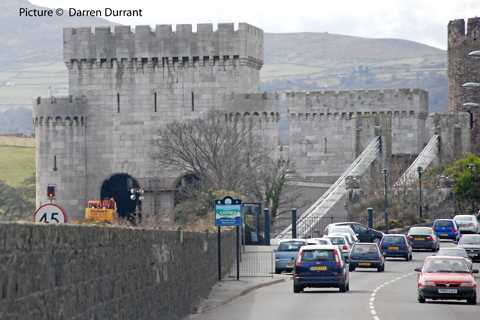
Relaying work was taking place in the Conwy Tubular Bridge area on 28 March. The road-rail machine in the view belongs to the Stobart Rail group. (Darren Durrant)
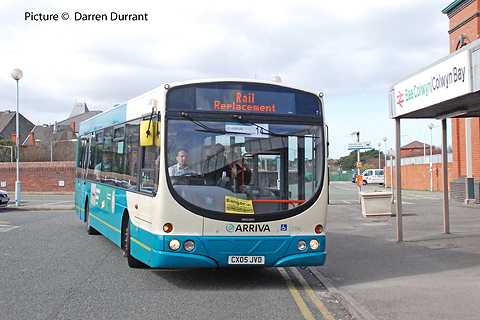
Arriva bus 2796 of Bangor depot was working the rail replacement service, seen at Colwyn Bay. This bus, a Volvo B7RLE with Wright Eclipse Urban bodywork, built in 2005, is one of a batch of seven which were taken over in 2008 from KMP of Llanberis along with their routes 9A and 9B, Llandudno and Llangefni and between Llandudno and Caernarfon. KMP is a believer in cherished registrations, and had registered this one as M7 KMP; Arriva have re-regisrered it CX05 JVD. (Darren Durrant)
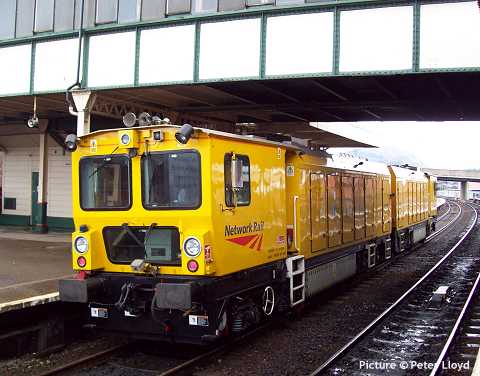
This Harsco Track Technologies RGH-20C Switch and Crossing Rail Grinder unit (we believe DR 79262 and DR 79272) arrived at Llandudno Junction on 29 March ready for overnight work. Rail grinding keeps the head of the rail smooth, and reveals any microscopic faults that might lead to cracks and disastrous rail failures such as occurred in the notorious Hatfield accident. (Peter Lloyd)
Steam specials
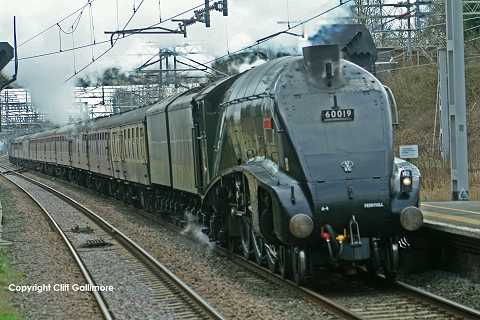
Saturday 27 March saw two steam trains making an appearance in Manchester. One was 'The Palatine' (revival of a the name of a one-time service train) which ran from London Euston to Manchester Piccadilly via Crewe, a simple itinerary but one which has not often been used for a steam charter. The locomotive for the northbound run was ex-LNER A4 pacific 60019 Bittern, not one that would have been seen on the original 'Palatine'! Picture above passing Sandbach station, by Cliff Gallimore, who writes: 'I remember this loco working the Aberdeen - Glasgow three-hour trains in 1966.'
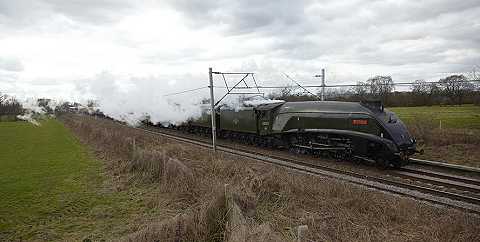
Passing Holmes Chapel (Stavros Lainas) - the reason why these locos were called 'streaks' by young locospotters is quite evident.
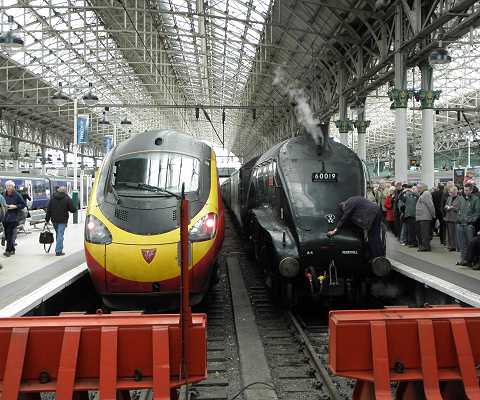
Streamliners old and new together at Manchester Piccadilly. The A4 is showing a home depot of 61B, Ferryhill (Aberdeen), this being its shed at the time of withdrawal from British Rail service. The last duties for the class under BR ownership were indeed the Aberdeen to Glasgow and Edinburgh expresses - they ended up on these duties after less than happy experiences operating the turns with unsuccessful Modernisation Plan diesels. (Tim Fenton)
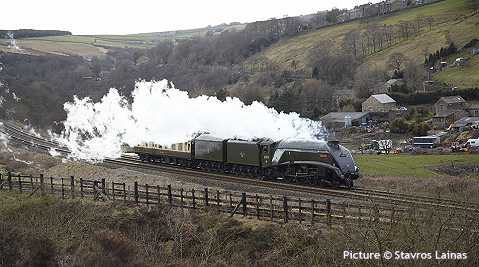
The diesel loco which had been on the rear of the train took the passengers back to London while 60019 and support coach headed for York via the Standedge route. Stavros Lainas caught up with them at Diggle abouit to enter Standedge tunnel: note the two tenders: the extra one carries water only.
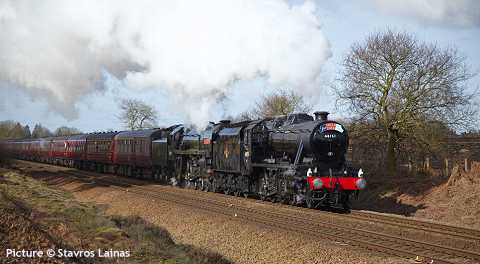
On the same day, a charter from Lancaster via Manchester Victoria to York was run to raise funds for the 'Help the Heroes' charity which supports wounded soldiers. The picture by Stavros Lainas shows the train at Golborne near Wigan, hauled by 8F 2-8-0 48151 and 'Britannia' pacific 70013, specially renamed for the day to represent scrapped classmate 70048 The Territorial Army 1908 - 1958. The original plan had been to have double-headed military-named locos, but unfortunately 46115 Scots Guardsman was not available, having suffered problems on earlier outings, so 48151 substituted.
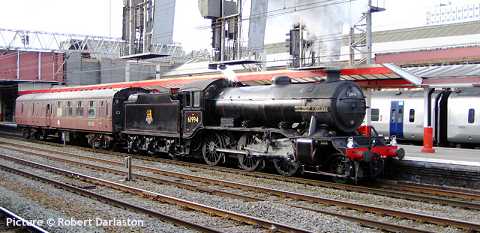
Robert Darlaston took this view of 61994 The Great Marquess, with support carriage, passing through platform 6 at Crewe, as the 06:37 Kidderminster, Severn Valley Railway, to Crewe Heritage Centre,on 16 March. The fashion for painting preserved locos in early BR liveries (suggesting perhaps the average age of people who can remember steam) can produce rather drab, even if totally authentic, effects when applied to locomotives not from a London Midland Region heritage. This is one of just six Class K4 locos built by the LNER to work the West Highland line; bought in the 1960s by David Lindsay, Viscount Garnock and restored to LNER apple green as no. 3442, it was one of the few privately-preserved locos to work on the main line before the great British Railways Steam Ban of 1968. Today it is owned by John Cameron.
Note: our Calendar page has been updated to include proposed steam trains on the main lines in our area for 2010. Details of any additions or corrections welcome.
How to re-lay track - report by Geoff Morris
On Sunday 28 March a section of the Up Main (across the canal at Chester Locks) was relaid. New rail had been lying in the four-foot of the Up Slow for some weeks (in fact you can see it in the photo of 66 843 on Chirk logs that appeared in the 9 March noticeboard) and I had been waiting for something to happen. Eventually it was announced that the lines from Chester to Wrexham and Rhyl would be closed on Sunday 28 March, so this seemed a likely date for the work to take place.
I first ventured down to the Locks around 10:00 (it might have been earlier if the clocks hadn't moved forward that morning) to find the work well under way with the Up Main removed for about 150 metres either side of the canal bridge and most of the old ballast already dug out and deposited into spoil wagons (hauled by 66 068). This was mainly done with a JCB-type vehicle although the section on the bridge had to be done by hand because the cross-beams would get in the way of the JCB.
At the rear of the spoil train were some wagons containing sand which was then dug out of the wagons and spread on the cleared trackbed. 66 068 then removed its train and was replaced by 66 167 which had been sitting on the Up Main alongside the racecourse with a train of ballast wagons.
Once the sand had been levelled then a black plastic membrane and mesh was rolled into position on top of the sand.
Ballast was then tipped from the wagons onto the formation and spread by the JCB.
The canal bridge again had to be dealt with by hand (and the help of a rail-mounted crane which lifted 'sacks' of ballast into position) and the bottom of the sacks was then opened).
Once the base ballast had been positioned then the second engineers' train, hauled by 66 067, was called into position. The first half of this carried concrete sleepers which were craned into position by a rail mounted crane with an attachment that allowed seven sleepers to be handled at a time.
Again the bridge was dealt with by hand, and wooden sleepers were placed on it.
Once the sleepers were positioned, a rail-mounted crane picked up the (welded) rail that had been lying all of the time in the 4-foot of the Up Slow and slewed into position. It was amazing to see how elastic the rail was and also how accurately the crane was able to position the rail relative to the clips that were already in the sleepers.
Next the ends of the welded rail had to be cut to fit exactly (with plenty of sparks) and the rail was then clipped into place by a fancy piece of kit that pushed the clips over the rail base, one sleeper at a time.
Finally, and most spectacularly, the new rails were welded to the ends of the untouched rail by Thermite welding ...
... with lots of flames.
I didn't visit again after this but all that really remained was for the final layer of ballast to be laid - the rear half of 66 136's train comprised auto-ballaster wagons which would have achieved this.
The line was open, with a speed restriction, by Monday: the picture above shows 158823 on a Holyhead service passing the site.
The attached sequence of photos was taken at different stages during the day. I wasn't there all the time - it's only about a 10-minute walk from my house so it was easy to pop back and forth to check on progress.
Tan-y-Bwlch: The view from the North (Press release)
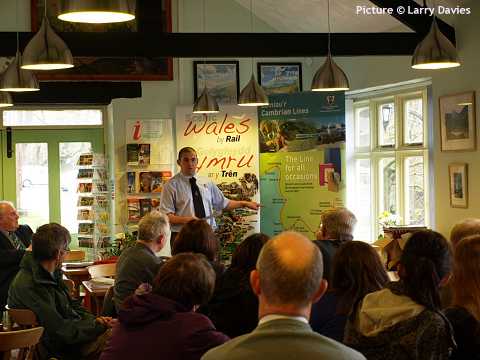
The Ffestiniog Railway teamed up with Arriva Trains Wales recently to host a familiarisation visit for local Tourist Information Centre and council staff, and accommodation providers from the Conwy, Llandudno and Betws-y-Coed areas.
After travelling up the Conwy Valley, they joined the 11:50 FR service as far as Tan y Bwlch station. After viewing the new playground, they were given a good lunch, partly funded by the Snowdonia National Park Authority and then, because there is no such thing as a free lunch, there was a series of talks to help them to sell the railways and surrounding area to their customers.
First Larry Davies, Rail Officer for the Conwy Valley, told them a little about the line and the importance of working together. Also, he emphasised how beautiful the line was beyond Betws-y-Coed and that there was usually spare capacity for extra customers. Local writer and raconteur, Huw Jenkins then took them a little further south as he presented the new Vale of Ffestiniog Project which brings together attractions, food and accommodation and explained the unique selling points of the valley. He also mentioned that things were changing in Blaenau and it promised to be a great place to send visitors for a day out.
Clare Britton, Commercial Manager for the Ffestiniog Railway, told the group about activities on both FR and WHR and also how the railway works to promote the whole area, explaining about the recent presence at BOBI (a tourism event held at Olympia in London). To finish, Gerwyn Jones, Rail Officer for the Cambrian Coast line, took them on a brief journey down his line past golf courses and real ale pubs (there is a leaflet on both!). The 14:10 service took them back to Blaenau in good time to catch the return train to Llandudno. Several had never been on the train before whilst others had not travelled for a while.
A good time was had by all and it will certainly help to promote Blaenau, its railways and the surrounding area.
North Wales Coast home page 2010 Archive Previous Noticeboard